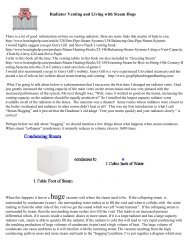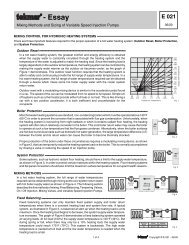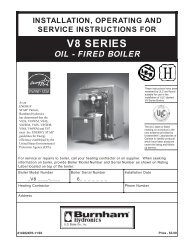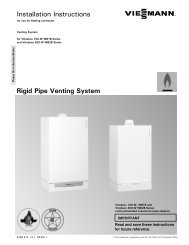Steam Locomotive Firebox Explosion on the Gettysburg Railroad ...
Steam Locomotive Firebox Explosion on the Gettysburg Railroad ...
Steam Locomotive Firebox Explosion on the Gettysburg Railroad ...
You also want an ePaper? Increase the reach of your titles
YUMPU automatically turns print PDFs into web optimized ePapers that Google loves.
INTRODUCTION<br />
At about 7:20 p.m. <strong>on</strong> June 16, 1995, <strong>the</strong><br />
crownsheet of <strong>Gettysburg</strong> Passenger Services,<br />
Inc., steam locomotive 1278 failed<br />
while <strong>the</strong> train was pulling a six-car excursi<strong>on</strong><br />
train about 15 mph near Gardners,<br />
Pennsylvania. The failure caused fire and<br />
steam to be explosively released through <strong>the</strong><br />
firebox door into <strong>the</strong> locomotive cab, seriously<br />
burning <strong>the</strong> engineer and two firemen.<br />
The engineer suffered third-degree burns<br />
over 65 percent of his body. N<strong>on</strong>e of <strong>the</strong> 310<br />
passengers or <strong>the</strong> o<strong>the</strong>r crewmembers were<br />
injured.<br />
The cause of this accident was determined<br />
to be <strong>the</strong> failure of <strong>the</strong> train operating<br />
crew to maintain a water level in <strong>the</strong> locomotive<br />
boiler that was sufficient to cover <strong>the</strong><br />
crownsheet. Because of <strong>the</strong> inadequate water<br />
level, <strong>the</strong> crownsheet overheated and weakened.<br />
When it weakened, it could no l<strong>on</strong>ger<br />
withstand <strong>the</strong> pressure of <strong>the</strong> steam above it.<br />
The pressure forced a secti<strong>on</strong> of <strong>the</strong> crownsheet<br />
to pull away from its staybolts and<br />
collapse inward; <strong>the</strong> staybolt holes in <strong>the</strong><br />
collapsed secti<strong>on</strong> <strong>the</strong>n exposed superheated<br />
water and steam in <strong>the</strong> boiler to <strong>the</strong> atmospheric<br />
pressure of <strong>the</strong> firebox. With <strong>the</strong> sudden<br />
reducti<strong>on</strong> of pressure in <strong>the</strong> boiler, <strong>the</strong><br />
superheated water flashed instantaneously<br />
and explosively into steam. The investigati<strong>on</strong><br />
of this accident revealed that those resp<strong>on</strong>sible<br />
for maintaining, repairing, and<br />
operating locomotive 1278 lacked <strong>the</strong> specialized<br />
training and experience that have<br />
l<strong>on</strong>g been judged to be prerequisites for <strong>the</strong><br />
safe operati<strong>on</strong> of steam-locomotive equipment.<br />
Approximately 150 steam locomotives<br />
are still operated in <strong>the</strong> United States by<br />
more than 82 organizati<strong>on</strong>s. Virtually all of<br />
<strong>the</strong>m are used by tourist railroads, museums,<br />
historical groups, and steam-excursi<strong>on</strong><br />
groups. Although <strong>the</strong>re are no exact figures<br />
about how many people ride steam-locomotive<br />
trains each year, <strong>the</strong> Tourist Railway<br />
Associati<strong>on</strong>, Inc., (TRAIN) estimates that<br />
approximately 4.8 milli<strong>on</strong> people, or <strong>the</strong><br />
equivalent of 12 percent of Amtrak’s annual<br />
intercity ridership for 1995, visit tourist<br />
railways, museums, and excursi<strong>on</strong> operati<strong>on</strong>s<br />
annually. A significant number of <strong>the</strong>se<br />
people ride trains pulled by steam locomotives.<br />
According to <strong>Gettysburg</strong> Passenger<br />
Services officials, about 50,000 people<br />
rode <strong>Gettysburg</strong> Passenger Services<br />
steam trains in 1994—and this is <strong>on</strong>ly <strong>on</strong>e of<br />
more than 80 organizati<strong>on</strong>s bel<strong>on</strong>ging to<br />
TRAIN that use steam-excursi<strong>on</strong> trains.<br />
This accident illustrates <strong>the</strong> hazards that<br />
are always present in <strong>the</strong> operati<strong>on</strong> of steam<br />
locomotives. The Safety Board is c<strong>on</strong>cerned<br />
that <strong>the</strong>se hazards may be becoming more<br />
significant because Federal regulatory c<strong>on</strong>trols<br />
are outdated and because expertise in<br />
operating and maintaining steam locomotives<br />
is diminishing steadily. The Safety<br />
Board believes that <strong>the</strong> reas<strong>on</strong>s for <strong>the</strong> explosi<strong>on</strong><br />
<strong>on</strong> locomotive 1278, especially<br />
those reas<strong>on</strong>s having to do with deficiencies<br />
in steam-locomotive maintenance and operati<strong>on</strong>s,<br />
may not be unique.<br />
1
















